The library of ESIEA (Journalists’ Union of Athens Daily Newspapers) is a specialised historical library, in possession of an abundant archive, as well as invaluable documents pertaining to journalism, politics, social evolution and the economy. As the president of ESIEA Maria T. Antoniadou points out in her foreword to the book The Library of ESIEA "Dimitris I. Pournaras", the Library feature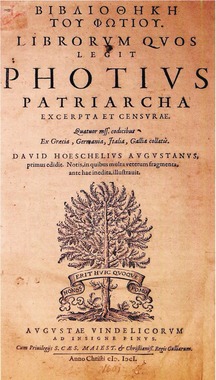 s rare publications hailing from the early 16th and 17th centuries, manuscripts, a plentiful photography collection, maps from various eras, documents pertaining to the Greek War of Independence, archives of drawings and caricatures and of course a large number of newspaper issues, both loose and bound. The most important artefacts of this collection are displayed in the special area of the Press Museum. The Library’s material is a result of donations from journalists as well as various market-level document acquisitions. Its rare exhibits, which are accessible to all, consist of approximately 60,000 volumes, documents and artefacts, the vast majority of which were acquired through donations from colleagues or their families. In addition to the history of the Greek press, readers will be able to access material from ancient Greek and Byzantine literature, rare editions, personal archives that contribute to their understanding of modern history, dictionaries, encyclopaedias, as well as a multitude of literary and historical titles.
s rare publications hailing from the early 16th and 17th centuries, manuscripts, a plentiful photography collection, maps from various eras, documents pertaining to the Greek War of Independence, archives of drawings and caricatures and of course a large number of newspaper issues, both loose and bound. The most important artefacts of this collection are displayed in the special area of the Press Museum. The Library’s material is a result of donations from journalists as well as various market-level document acquisitions. Its rare exhibits, which are accessible to all, consist of approximately 60,000 volumes, documents and artefacts, the vast majority of which were acquired through donations from colleagues or their families. In addition to the history of the Greek press, readers will be able to access material from ancient Greek and Byzantine literature, rare editions, personal archives that contribute to their understanding of modern history, dictionaries, encyclopaedias, as well as a multitude of literary and historical titles.
Following its reconstruction, the Library has attracted the attention of people who had not visited the Union building up to that point. Its reading 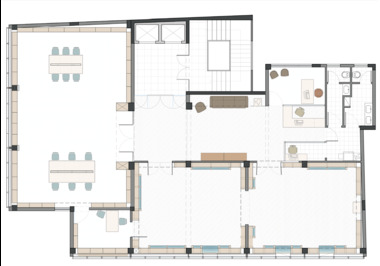 room also functions as a museum in order to highlight the Union’s history and reintroduce their work to the public. Eleni Karkazi-Pournara and Nikos D. Pournaras, children of the former President of ESIEA Dimitris I. Pournaras additionally donated some 1,000 representative volumes from their father's personal collection, which amounts to 4,000 rare volumes total.
room also functions as a museum in order to highlight the Union’s history and reintroduce their work to the public. Eleni Karkazi-Pournara and Nikos D. Pournaras, children of the former President of ESIEA Dimitris I. Pournaras additionally donated some 1,000 representative volumes from their father's personal collection, which amounts to 4,000 rare volumes total.
History. The Journalists’ Union (ESIEA) was established after two failed attempts (1903, 1908) on December 14, 1914. 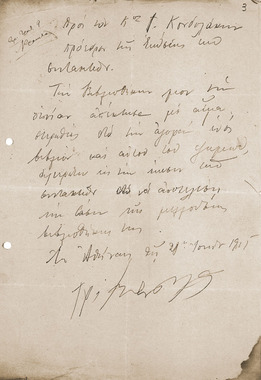 The journalist and writer Ioannis Kondylakis served as its first President (1862– 1920). Among the first members were journalists and writers, such as Kostis Palamas, Grigorios Xenopoulos and Costas Ouranis. On June 28 1915, the young journalist Grigoris Vassilas, a war correspondent for the newspaper Nea Imera, lost his life having crossed Macedonia on foot while monitoring the two Balkan wars. His bequeathment to the Journalists’ Union became the Library’s cornerstone. His words (“I acquired my library with blood, depriving myself of bread itself in order to buy a book.”) as well as his hope that his donation could “serve as the foundation of [the Union’s] future Library” reverberated throughout the period of the reconstruction and prosperity of the library that began in 1966.
The journalist and writer Ioannis Kondylakis served as its first President (1862– 1920). Among the first members were journalists and writers, such as Kostis Palamas, Grigorios Xenopoulos and Costas Ouranis. On June 28 1915, the young journalist Grigoris Vassilas, a war correspondent for the newspaper Nea Imera, lost his life having crossed Macedonia on foot while monitoring the two Balkan wars. His bequeathment to the Journalists’ Union became the Library’s cornerstone. His words (“I acquired my library with blood, depriving myself of bread itself in order to buy a book.”) as well as his hope that his donation could “serve as the foundation of [the Union’s] future Library” reverberated throughout the period of the reconstruction and prosperity of the library that began in 1966.
Our next reference point is 1919, when the painter Georgios N. Roilos (1867–1928) painted thirteen portraits of journalists and writers that decorate the building of ESIEA. Stylistically, these portraits are a 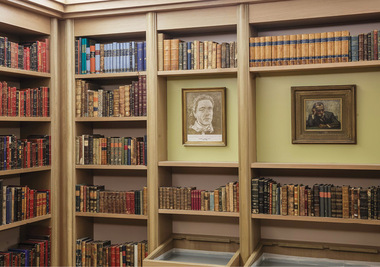 continuation of his well-known painting The Poets at Parnassos (G. Drossinis, G. Stratigis, I. Polemis, K. Palamas, G. Souris, A. Proveleggios), an oil painting from 1916–1917 presented in an exhibition of the painter in 1919. On April 5 1924, the Journalists' Union absorbed the General Writers' Association, whose members join its ranks, giving new impetus to the organisation. During that same year, the first issue of the satirical magazine of the Journalists’ Union Φανὸς τῶν συντακτῶν [Editor’s Lantern] is released; its publication will continue until 1940. In 1925, the School of Journalism was established, with weekly courses in the form of lectures, followed by the Pension Fund for Athens Newspaper Staff a year later. In 1929, The Greek Year: Almanac of the Journalists’ Union is published, on the initiative of Union President Aristos Kampanis.
continuation of his well-known painting The Poets at Parnassos (G. Drossinis, G. Stratigis, I. Polemis, K. Palamas, G. Souris, A. Proveleggios), an oil painting from 1916–1917 presented in an exhibition of the painter in 1919. On April 5 1924, the Journalists' Union absorbed the General Writers' Association, whose members join its ranks, giving new impetus to the organisation. During that same year, the first issue of the satirical magazine of the Journalists’ Union Φανὸς τῶν συντακτῶν [Editor’s Lantern] is released; its publication will continue until 1940. In 1925, the School of Journalism was established, with weekly courses in the form of lectures, followed by the Pension Fund for Athens Newspaper Staff a year later. In 1929, The Greek Year: Almanac of the Journalists’ Union is published, on the initiative of Union President Aristos Kampanis. 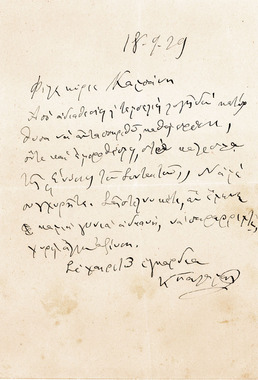 This important edition will only reoccur one more time, in 1930. Between 1933 and 1934, the efforts to establish the Union’s Library are aided by donations of books and archival material. In 1936, the Journalists’ Lottery is officially established following efforts that began in 1932. The Journalists’ Lottery and the annual dance of the Journalists’ Union helped gather the funds necessary for the Union to fulfill its purposes. During the 1938-1939 season, the Library of the Journalists’ Union is enriched thanks to two important donations: the journalist and close associate of Eleftherios Venizelos Ioannis M. Dambergis (1862–1938) donates his library while still alive, whereas the books, archive, office furniture and other personal effects of the journalist and cosmopolitan writer Dolis Nikvas (Apostolos N. Vassileiadis, 1903-1937) as well as three other portraits (Dionysios Solomos by Alekos Kontopoulos, A. Papadiamantis by A. Geralis, G. Souris etc.) featured at ESIEA were donated to ESIEA on 03.04.1939 by his mother.
This important edition will only reoccur one more time, in 1930. Between 1933 and 1934, the efforts to establish the Union’s Library are aided by donations of books and archival material. In 1936, the Journalists’ Lottery is officially established following efforts that began in 1932. The Journalists’ Lottery and the annual dance of the Journalists’ Union helped gather the funds necessary for the Union to fulfill its purposes. During the 1938-1939 season, the Library of the Journalists’ Union is enriched thanks to two important donations: the journalist and close associate of Eleftherios Venizelos Ioannis M. Dambergis (1862–1938) donates his library while still alive, whereas the books, archive, office furniture and other personal effects of the journalist and cosmopolitan writer Dolis Nikvas (Apostolos N. Vassileiadis, 1903-1937) as well as three other portraits (Dionysios Solomos by Alekos Kontopoulos, A. Papadiamantis by A. Geralis, G. Souris etc.) featured at ESIEA were donated to ESIEA on 03.04.1939 by his mother.
During the difficult years between 1940 and 1944, the German and Italian occupiers dismiss the Board of Directors of the Journalists’ Union and requisition its building. The Consumers’ Association is founded by the Union for the survival of its members. Books and records are burned by the Nazi occupiers for heating. The Union transports everything it can to the building on Pesmazoglou street and later to warehouses, as it was forced to sell the building in order to aid its members. The deterioration and destruction of books, archives and furniture continued due to poor storage conditions in unsuitable facilities. In 1966, the journalist Panagiotis Patrikios (1911–2007) voluntarily undertakes the organisation 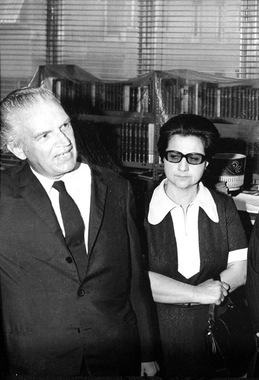 of the Library and the Press Museum of ESIEA, at its new building on the intersection of 20, Akadimias street and Voukourestiou street. Part of the building’s second floor is allocated for the library. Only 147 volumes had been preserved and a few hundred more were added by direct contributions from ESIEA members. The entire effort is supported by the Board of Directors of ESIEA, and its President, Leonidas Petromaniatis. With the inauguration of the building and the library, in the presence of the state and political leadership, the great and successful effort to establish the library is off to an auspicious beginning. Another landmark occasion was the Press and manuscript exhibition, 1821–1831 (20 December 1917 – 15 January 1972), as part of the celebration of the 150th anniversary of the Greek Revolution of 1821, with the catalogue of 151 exhibits being published. March 10, 1976 marks the occasion of the honorary event dedicated to The press and journalists of the National Resistance. That same year, a series of honorary events were hosted on April 16 and 18 dedicated to Johann Jakob Meyer (1798–1826), a Swiss Philhellene, publisher of the newspaper Ελληνικά Χρονικά [Greek Annals], (published in Messolonghi from 1824 to 1826) on the 150th anniversary of his death during the Sortie of Messolonghi. They were followed by an event at the ESIEA building (April 16, 1976), an exhibition of documents and publications and a concurrent event at the Mayer Monument in Messolonghi (April 18, 1976), in the presence of state and political authorities. The speeches given, a selection of Meyer’s texts from the Greek Annals, as well as the testimonies of Greek freedom fighters were published by ESIEA in 1980 in a volume entitled Johann Jakob Meyer: “Publication is the soul of justice”. Between 10 and 31 October 1976, the exhibition Thessalian Press 1880-1976 took place, followed by the book fair Journalists, writers, members of ESIEA from 6 to 22 December 1979.
of the Library and the Press Museum of ESIEA, at its new building on the intersection of 20, Akadimias street and Voukourestiou street. Part of the building’s second floor is allocated for the library. Only 147 volumes had been preserved and a few hundred more were added by direct contributions from ESIEA members. The entire effort is supported by the Board of Directors of ESIEA, and its President, Leonidas Petromaniatis. With the inauguration of the building and the library, in the presence of the state and political leadership, the great and successful effort to establish the library is off to an auspicious beginning. Another landmark occasion was the Press and manuscript exhibition, 1821–1831 (20 December 1917 – 15 January 1972), as part of the celebration of the 150th anniversary of the Greek Revolution of 1821, with the catalogue of 151 exhibits being published. March 10, 1976 marks the occasion of the honorary event dedicated to The press and journalists of the National Resistance. That same year, a series of honorary events were hosted on April 16 and 18 dedicated to Johann Jakob Meyer (1798–1826), a Swiss Philhellene, publisher of the newspaper Ελληνικά Χρονικά [Greek Annals], (published in Messolonghi from 1824 to 1826) on the 150th anniversary of his death during the Sortie of Messolonghi. They were followed by an event at the ESIEA building (April 16, 1976), an exhibition of documents and publications and a concurrent event at the Mayer Monument in Messolonghi (April 18, 1976), in the presence of state and political authorities. The speeches given, a selection of Meyer’s texts from the Greek Annals, as well as the testimonies of Greek freedom fighters were published by ESIEA in 1980 in a volume entitled Johann Jakob Meyer: “Publication is the soul of justice”. Between 10 and 31 October 1976, the exhibition Thessalian Press 1880-1976 took place, followed by the book fair Journalists, writers, members of ESIEA from 6 to 22 December 1979.
By 1980, the idea of an organised and substantial library and press museum in ESIEA had become a priority, resulting in a vast increase in donations of book collections and archives. The successful course of the Library also highlights the problems created by the lack of space and staff. Among the dozens of donations of books and archival material, let us mention the collections of Haris Stamatiou (1890–1951), Nikos Veros, George Tsimbidaros-Fteris (1891–1967), Alexandros Paradisis (1899–1977), Maria Christina Louriotis, Giannis Zografou, Fotos Giofyllis (Spyros Mousouris, 1887–1981), 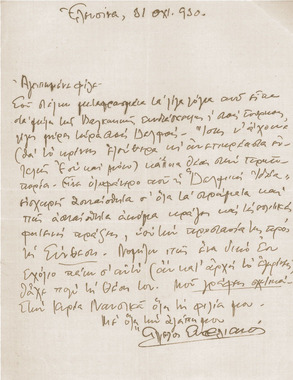 Kostas Politis, Gerasimos Lychnos (1894–1976), Panagiotis Patrikios, Apostolos V. Daskalakis (1900–1982), Kornilios Angelidis (1900– 1985), Costas Seizan, Tasos Vournas (1907–1985), and Iraklis N. Petimezas. In 1980, from October 27 to November 11, the press exhibition Τhe contribution of journalism to the war 1940–1941 was held. The exhibition 137 years of Greek Caricature 1844-1981 followed from 2 to 12 April 1981. In 1998, the Cultural Foundation of ESIEA was established. Its purpose includes “housing the Library and the Press Museum and collecting, utilising and promoting its material, as well as all material concerning the history of the Press and other media and journalism in general.” In 2007, Panagiotis Patrikios passes away at the age of 96, leaving his vision and work for the establishment of the Library and Press Museum of ESIEA in need of successors. 2014 marks the centennial anniversary of ESIEA. The anniversary is celebrated with a series of events at the Union building. Valuable samples of its archives and a small part of the Library are presented.
Kostas Politis, Gerasimos Lychnos (1894–1976), Panagiotis Patrikios, Apostolos V. Daskalakis (1900–1982), Kornilios Angelidis (1900– 1985), Costas Seizan, Tasos Vournas (1907–1985), and Iraklis N. Petimezas. In 1980, from October 27 to November 11, the press exhibition Τhe contribution of journalism to the war 1940–1941 was held. The exhibition 137 years of Greek Caricature 1844-1981 followed from 2 to 12 April 1981. In 1998, the Cultural Foundation of ESIEA was established. Its purpose includes “housing the Library and the Press Museum and collecting, utilising and promoting its material, as well as all material concerning the history of the Press and other media and journalism in general.” In 2007, Panagiotis Patrikios passes away at the age of 96, leaving his vision and work for the establishment of the Library and Press Museum of ESIEA in need of successors. 2014 marks the centennial anniversary of ESIEA. The anniversary is celebrated with a series of events at the Union building. Valuable samples of its archives and a small part of the Library are presented.
In the spring of 2018, the family of journalist, writer, politician and President of ESIEA Dimitris I. Pournaras (1900–1986) decides to sponsor the project of the infrastructure restoration, equipment and arrangement of the Library and Press Museum of ESIEA, following a proposal by ESIEA President Maria T. Antoniadou. From the summer to the fall of the same year, the architect and book 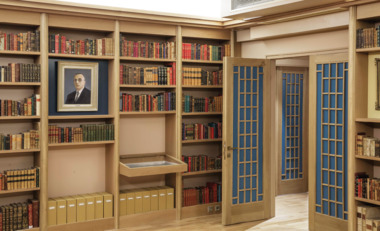 historian Konstantinos Sp. Staikos, in collaboration with ESIEA, undertakes and completes the reconstruction of the infrastructure and equipment, as well as the arrangement of the Library, Archive and Museum of ESIEA. Triantafyllos E. Sklavenitis, historian and Director Emeritus of Research at the National Hellenic Research Foundation collaborates as scientific advisor on the book collections. The inauguration of the newly arranged Library and Press Museum of ESIEA takes place on December 2, 2018, in the presence of the President of the Hellenic Republic, Prokopios Pavlopoulos and His Beatitude Ieronymos II, Archbishop of Athens and All Greece. During the next two years, Εleni Karkazi-Pournara sponsors the process of classification and cataloguing for the books of the ESIEA Reading Room, as well as the classification and cataloguing of the ESIEA Archive and Archival Collections. Part of Dimitrios I. Pournaras’ personal library was then donated to the library of ESIEA in 2019 by his children Eleni Karkazi-Pournara and Nikos D. Pournaras. On May 23, 2019, His All Holiness, the Ecumenical Patriarch Bartholomew is invited to the ESIEA Library, where he is given an extensive tour and delivers an address. In November 2020, the recruitment of Olga Paraskeva, MSc librarian, strengthened the process of cataloguing and classifying the contents of the collection. A proposal was prepared and submitted to the Cultural Foundation and Administration of ESIEA regarding the establishment of procedures that will allow readers access to the Library, and the development of services in the fields of research, documentation, education and promotion of the Library to a wider audience.
historian Konstantinos Sp. Staikos, in collaboration with ESIEA, undertakes and completes the reconstruction of the infrastructure and equipment, as well as the arrangement of the Library, Archive and Museum of ESIEA. Triantafyllos E. Sklavenitis, historian and Director Emeritus of Research at the National Hellenic Research Foundation collaborates as scientific advisor on the book collections. The inauguration of the newly arranged Library and Press Museum of ESIEA takes place on December 2, 2018, in the presence of the President of the Hellenic Republic, Prokopios Pavlopoulos and His Beatitude Ieronymos II, Archbishop of Athens and All Greece. During the next two years, Εleni Karkazi-Pournara sponsors the process of classification and cataloguing for the books of the ESIEA Reading Room, as well as the classification and cataloguing of the ESIEA Archive and Archival Collections. Part of Dimitrios I. Pournaras’ personal library was then donated to the library of ESIEA in 2019 by his children Eleni Karkazi-Pournara and Nikos D. Pournaras. On May 23, 2019, His All Holiness, the Ecumenical Patriarch Bartholomew is invited to the ESIEA Library, where he is given an extensive tour and delivers an address. In November 2020, the recruitment of Olga Paraskeva, MSc librarian, strengthened the process of cataloguing and classifying the contents of the collection. A proposal was prepared and submitted to the Cultural Foundation and Administration of ESIEA regarding the establishment of procedures that will allow readers access to the Library, and the development of services in the fields of research, documentation, education and promotion of the Library to a wider audience.
The Reconstruction of the Library. Once it was decided in 2018 that the Archive and Library of ESIEA would be housed on the second floor of the Union’s headquarters (20, Akadimias Street & Voukourestiou, at Kolonaki),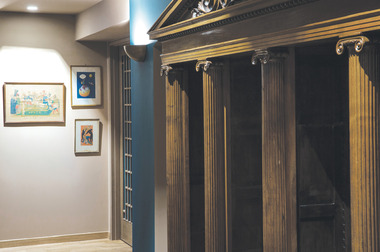 this level was studied in order to ensure that it would meet the modern requirements of an organised library, and its purpose of serving the needs of researchers and a wider readership alike. The primary concern in terms of architectural design was to come up with a layout that would highlight the treasures of the ESIEA Library and its long tradition — with paintings depicting some of its presidents, as well as eminent representatives from the worlds of journalism and literature. Therefore, two main areas were selected, around which the rest were developed.
this level was studied in order to ensure that it would meet the modern requirements of an organised library, and its purpose of serving the needs of researchers and a wider readership alike. The primary concern in terms of architectural design was to come up with a layout that would highlight the treasures of the ESIEA Library and its long tradition — with paintings depicting some of its presidents, as well as eminent representatives from the worlds of journalism and literature. Therefore, two main areas were selected, around which the rest were developed.
The reading room. Floor-to-ceiling bookcases were fitted on the interior and exterior walls of an 11 x 8 room (90 sq. m.), leaving open only a small part of the glazing overlooking the façade. T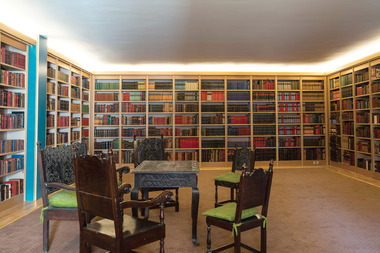 he bookcases have movable shelves to accommodate any library classification adopted by the Heads of the Library. Two special reading desks were placed in this room, which can serve a total of 12 people at a time. The desks are equipped with all the necessary electronic terminals for connection to all kinds of networks and are self-illuminated independently of the space. The floor is covered with carpeting, an ideal solution in case of frequent movements, and is defined by a wooden siding that ends in the bookcases. About 10,000 volumes were placed in the bookcases of the Reading Room, arranged thematically based on a previous sorting system. These are books of general interest, most of them encyclopaedic in nature:
he bookcases have movable shelves to accommodate any library classification adopted by the Heads of the Library. Two special reading desks were placed in this room, which can serve a total of 12 people at a time. The desks are equipped with all the necessary electronic terminals for connection to all kinds of networks and are self-illuminated independently of the space. The floor is covered with carpeting, an ideal solution in case of frequent movements, and is defined by a wooden siding that ends in the bookcases. About 10,000 volumes were placed in the bookcases of the Reading Room, arranged thematically based on a previous sorting system. These are books of general interest, most of them encyclopaedic in nature: 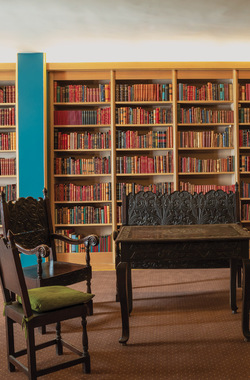 dictionaries and all kinds of special thematic studies, large encyclopaedias and old editions of the daily press, historical books about the ancient and Byzantine era and about the survival of Greek culture in various regions throughout the period of Ottoman rule. Many volumes contain historical texts written after the founding of the Greek state, as well as collections tracing the intellectual achievements of the Greeks through poetry and prose. Among the books, there are also many copies of foreign language publications of great interest, regarding not only Greek policies, but also those of many other European nations. From the main entrance of the Library, one enters the Reading Room through a four-leaf door, while a single-leaf door leads to the librarian’s space, through which communication with the museum rooms is also possible.
dictionaries and all kinds of special thematic studies, large encyclopaedias and old editions of the daily press, historical books about the ancient and Byzantine era and about the survival of Greek culture in various regions throughout the period of Ottoman rule. Many volumes contain historical texts written after the founding of the Greek state, as well as collections tracing the intellectual achievements of the Greeks through poetry and prose. Among the books, there are also many copies of foreign language publications of great interest, regarding not only Greek policies, but also those of many other European nations. From the main entrance of the Library, one enters the Reading Room through a four-leaf door, while a single-leaf door leads to the librarian’s space, through which communication with the museum rooms is also possible.
Library-Museum. Two interconnecting rooms were arranged, approximately 8×5 each, i.e. a total area of 80 sq.m. Two double doors lead to these rooms from the main entrance of the Library. 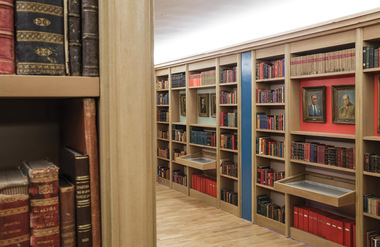 Their floors were covered with oak flooring, while specially designed bookcases with recesses and display cases were fitted onto the interior and exterior walls. These wall units were designed so that portraits of ESIEA presidents, most of them made by G. N. Roilos, could be placed in the recesses, while handwritten and printed material was exhibited in the display cases, which can also host periodic thematic exhibitions, on anniversaries or other occasions. Apart from the Reading Room and Museum areas, the central elongated area of the reception leads to the office intended for the head of the Library, which also houses the book collection of Dimitris I. Pournaras.
Their floors were covered with oak flooring, while specially designed bookcases with recesses and display cases were fitted onto the interior and exterior walls. These wall units were designed so that portraits of ESIEA presidents, most of them made by G. N. Roilos, could be placed in the recesses, while handwritten and printed material was exhibited in the display cases, which can also host periodic thematic exhibitions, on anniversaries or other occasions. Apart from the Reading Room and Museum areas, the central elongated area of the reception leads to the office intended for the head of the Library, which also houses the book collection of Dimitris I. Pournaras.
Contents of the Library and Archive. In both of the library’s entry catalogues, 25,000 titles of books and volumes of periodicals have been recorded from 1966 to 1995. 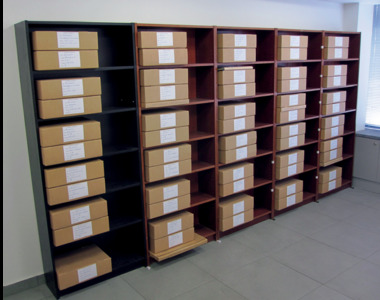 Most of this material comes from donations, with only 5% coming from direct purchases. So many more books, periodicals and newspapers from donations remain unrecorded, since the lack of space and staff did not allow for their registration. The part of the ESIEA Archive that survived had not been recorded until 2018, much like the more than 20 personal archives that had been donated until then. Two accurate bulletin catalogues had been compiled: One of 108 files from the ESIEA Archive (1895–1949) compiled in 1992–1993, and a detailed catalogue of 180 historical documents (1821–1862) from the Haris Stamatiou Collection. Regarding the process of classification and cataloguing that started in 2019 at the Library and Archive, we refer readers to the article “Χαρτογράφηση ενός νέου Αρχείου. Τα αρχεία της Ένωσης Συντακτών Ημερησίων Εφημερίδων Αθηνών” [“Mapping a new Archive. The archives of the Journalists’ Union of Athens Daily Newspapers”] by Dimitris Sklavenitis, Τα Ιστορικά [Historica] magazine, year 37, issue 71, October 2020, pp. 236–242.
Most of this material comes from donations, with only 5% coming from direct purchases. So many more books, periodicals and newspapers from donations remain unrecorded, since the lack of space and staff did not allow for their registration. The part of the ESIEA Archive that survived had not been recorded until 2018, much like the more than 20 personal archives that had been donated until then. Two accurate bulletin catalogues had been compiled: One of 108 files from the ESIEA Archive (1895–1949) compiled in 1992–1993, and a detailed catalogue of 180 historical documents (1821–1862) from the Haris Stamatiou Collection. Regarding the process of classification and cataloguing that started in 2019 at the Library and Archive, we refer readers to the article “Χαρτογράφηση ενός νέου Αρχείου. Τα αρχεία της Ένωσης Συντακτών Ημερησίων Εφημερίδων Αθηνών” [“Mapping a new Archive. The archives of the Journalists’ Union of Athens Daily Newspapers”] by Dimitris Sklavenitis, Τα Ιστορικά [Historica] magazine, year 37, issue 71, October 2020, pp. 236–242.
The Library of ESIEA “Dimitris I. Pournaras”, 2nd edition: edited by K. Sp. Staikos / Triantafyllos E. Sklavenitis, Athens, [ESIEA], 2021.